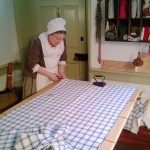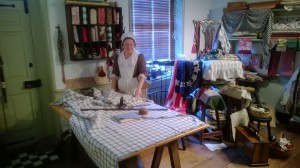
I got a lovely email last week about a new living history exhibit. Im a little late in posting about due to house plumbing issues,
but if anyone is in the Philadelphia area it sounds like a great project to check out.
Because I am nosy I asked some questions about the hand stitches that will be used in this project and got a reply back!
From Carol Spacht who is leading the project:
“The stiches are all very simple: running stitch, back-stitch, combination stitch (running & backstitch together) & plain hem stitch. Seams with raw edges are felled, and seams with selvedges are stitched with either combination or backstitch, and then simply pressed; we are not felling or otherwise finishing-off selvedge seams. In the course of the project, we will be making many eyelets.
We will use a plain overcast stitch (no pearls) for the eyelets; we will also over-hand selvedges when we join the pieces of linen together for the counterpane and, just for variation, we’ll do a Holland seam for the sheet – a slightly different stitch that is similar to over-handing. Other stitches that we use with frequency in the shop include: overcasting raw edges, whipstitch, and spaced back-stitch. An interesting question that we are sometimes asked in the shop, regards the period names for stitches.
We have chosen to rely upon the research of Kathleen Kannik,The Lady’s Guide to Plain Sewing. Stitches often have variant names, but it appears that many of the common names that we know stitches by today, were also probably used in the 18th century.”
“DRESSING THE BED” EXHIBIT UNDERWAY AT BETSY ROSS HOUSE;
LIVING EXHIBIT HIGHLIGHTS 18TH CENTURY UPHOLSTERY TRADE
